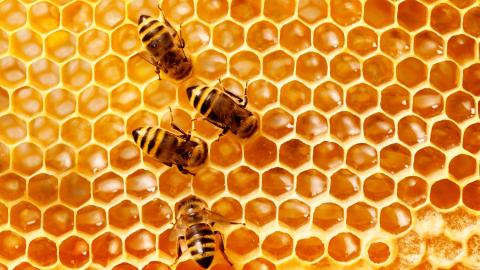Researchers breed a fungus that kills mites to save bees

Credit: BigBlueStudio/Adobe Stock
- Honeybee colony collapse is due in part to Varroa mites that weaken honey bee immune systems.
- Chemicals that were once effective against the mites are no longer working as well.
- Researchers are stepping in with a newly cultured fungus that goes after the mites without bothering the bees.
Honey bees are vitally important to agriculture — by some estimates, they’re responsible for pollinating more than 80 crops, adding up to about one third of the crops that we eat. The USDA says they add at least $15 billion of value annually to U.S. crops in the form of higher yields and increased harvest quality. Humanity has a vested interest in helping to maintain healthy honeybee populations.
One problem for honeybees is a phenomenon known as Colony Collapse Disorder (CCD), which was first identified in 2006. With CCD, all adult bees in a hive die, leaving behind a queen, some immature bees, and honey. According to entomologist Sammy Ramsey, bees remain under pressure from what he calls the three Ps: parasites, pesticides, and poor nutrition.
Varroa destructor mites are a big part of that first P. They feed on bees — sucking fat from their bodies — leaving them with weakened immune systems that make the bees more susceptible to disease. Now entomologists at Washington State University (WSU) have developed a new strain of a mold-like fungus, Metarhizium, that can eradicate the mites. It does so without miticides, chemicals against which the mites are becoming increasingly resistant. The team’s study is published in Scientific Reports.
Metarhizium made for the hive environment
Metarhizium killing varroa timelapse
youtu.beAccording to author Steve Sheppard of WSU’s Department of Entomology, “We’ve known that metarhizium could kill mites, but it was expensive and didn’t last long because the fungi died in the hive heat.” The team’s innovation was breeding a strain that can thrive in a hive. “Our team used directed evolution to develop a strain that survives at the higher temperatures.”
There should be no safety issues introducing Metarhizium into a colony as bees are highly resistant to its spores. When Metarhizium encounters a mite, it drills into it before proliferating and killing the mite from the inside, as shown above.
As they cultured their Metarhizium, the researchers screened over 27,000 mites to identify the most deadly variants. “It was two solid years of work, plus some preliminary effort,” says lead author Jennifer Han. When they arrived at their final Metarhizium, “We did real-world testing to make sure it would work in the field, not just in a lab.”
Not their first fungus
The new strain of Metarhizium is the second agent the researchers have developed to aid bee colonies. In 2018, they announced the development of a mycelium extract that reduced virus levels in bees.
Together with their earlier invention, fungus expert Paul Stamets says the team has put together “a real one-two punch, using two different fungi to help bees fight varroa. The extracts help bee immune systems reduce virus counts while the metarhizium is a potentially great mite biocontrol agent.”
(Star Trek Discovery fans may note that the crew member who interacts with a universal mycelial network is named… “Paul Stamets.”)
Two things have to happen now before WSU’s Metarhizium can be released to agricultural hives. First, the team has to nail down the optimal steps by which beekeepers can introduce the fungus to their bee colonies. Second, the Environmental Protection Agency has to approve Metarhizium for use.





